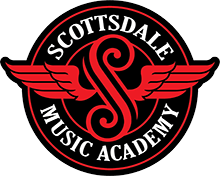There’s a right way and wrong way to do most everything, including singing high notes. Learning how to sing high notes the right way (i.e. without straining your voice) can be tricky for a majority of singers to master, especially without guidance. Luckily, Scottsdale Music Academy is here to help! We’ve compiled some simple and basic tips to help you conquer the difficult task of singing high notes. Read on to learn more.
1. Always Warm Up
The key to singing high notes without straining your vocal cords is to think of your voice like a machine…. specifically, like a car. It should be no surprise that few cars (if any) can go from 0 mph to 100 mph instantaneously. It takes time for a car’s engine to warm up and for all parts of the car to work together at such high levels. The same basic concept is true for your voice! The biggest mistake singers make is trying to belt out high notes when their voice isn’t first warmed up or properly trained. The end result is usually nothing but strain and pain (the vocal equivalent of screeching tires). Thankfully, you can avoid that unpleasant scenario by doing a few simple vocal exercises beforehand and gradually building your vocal strength over time.
2. Know Your Vocal Register
In our many years of teaching voice lessons, we’ve seen one too many singers try to reach notes outside of their natural vocal register. The reality is every singer has vocal limitations that prevent them from singing certain notes. While it’s true that singers can expand their vocal register through practice and techniques, eventually there is a cutoff point. In other words, don’t try to belt out a note that’s too far outside your normal range since your voice likely isn’t naturally equipped to reach that high.
3. Control Your Air Flow
Another critical component to singing high notes is adequate airflow. More specifically, a steady and powerful flow of air. Not surprisingly, it takes a lot of air to not only reach high notes but reach them without running out of steam. To do that, you’ll need the right breath support which stems from the diaphragm. To master your airflow, you’ll need to be mindful of your diaphragm and learn to breathe from it. Ideally, when singing, you should take deep, steady and controlled breaths from the diaphragm (not the chest). Learning to breathe from the diaphragm takes time, but it’s so worth it!
4. Be Mindful of Posture
If there’s one thing singers hear over and over again it’s the importance of good posture! Believe it or not, good posture is critical for hitting high notes. For extra help reaching those elusive notes, be sure to stand correctly: chest held high, shoulders down, back, and relaxed while engaging the core.
Singing high notes isn’t easy by any means but it is doable. To learn even more expert singing techniques and get personalized help from professional singers, contact Scottsdale Music Academy or sign up for vocal lessons today!

